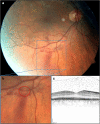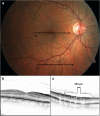Nd:YAG Laser Hyaloidotomy for the Treatment of Acute Subhyaloid Hemorrhage: A Comparison of Two Cases
- PMID: 26693725
- PMCID: PMC4909670
- DOI: 10.1007/s40123-015-0043-1
Nd:YAG Laser Hyaloidotomy for the Treatment of Acute Subhyaloid Hemorrhage: A Comparison of Two Cases
Abstract
Introduction: Subhyaloid hemorrhage, whether spontaneous or in the context of a Valsalva maneuver, can lead to an acute decrease in vision when located in the premacular region. Nd:YAG laser hyaloidotomy (NYLH) is a minimally invasive treatment option.
Methods: We examined two different clinical courses based on two case reports of NYLH. One case report described a 52-year-old female patient who presented with a painless decrease of vision to 20/200. The fundoscopy verified a subhyaloid premacular hemorrhage. The precipitating event for the hemorrhage could not be determined, and a NYLH was performed 5 days after the event. The other patient was a 48-year-old man who suffered an acute visual decrease (hand motion) after developing a migraine with vomiting. Fundoscopy showed a dense subhyaloid premacular hemorrhage. NYLH was performed 1 day after the hemorrhage. These clinical courses were documented based on fundus photographs, ultrasounds, and spectral-domain optical coherence tomography (SD-OCT).
Results: In both cases, there was an effect with approximately 2.2 mJ of laser energy. In the female patient, we observed a gradual but constant increase in vision. After 4 weeks, her vision improved to 20/20. In the male patient, the vision increased to 25/20 1 day after treatment. However, his vision returned to hand motion as he developed a diffuse vitreous opacification. Because of delayed reabsorption, vitrectomy was considered. Since the optical axis was clear with good vision, we decided against this surgery. Complete reabsorption took more than 3 months.
Conclusion: After NYLH for subhyaloid hemorrhage, pronounced vitreous body opacification could develop despite a rapid increase in vision, and requires close monitoring by the surgeon. Fundus photography and SD-OCT are suitable means for clinical course evaluations.
Keywords: Nd:YAG laser; Nd:YAG laser hyaloidotomy; Premacular subhyaloidal bleeding; Valsalva maneuver; Vitreous hemorrhage.
Figures





References
LinkOut - more resources
Full Text Sources
Other Literature Sources

